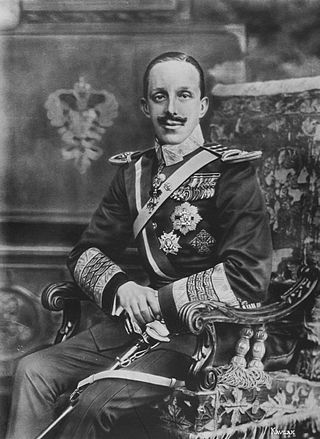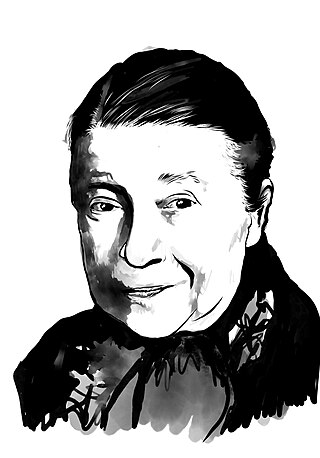
Alfonso XIII, also known as El Africano or the African due to his Africanist views, was King of Spain from his birth until 14 April 1931, when the Second Spanish Republic was proclaimed. He became a monarch at birth as his father, Alfonso XII, had died the previous year. Alfonso's mother, Maria Christina of Austria, served as regent until he assumed full powers on his sixteenth birthday in 1902.

The tooth fairy is a folkloric figure of early childhood in Western and Western-influenced cultures. The folklore states that when children lose one of their baby teeth, they should place it underneath their pillow or on their bedside table; the Tooth Fairy will visit while they sleep, replacing the lost tooth with a small payment.

Marie-Catherine Le Jumel de Barneville, Baroness d'Aulnoy, also known as Countess d'Aulnoy, was a French author known for her literary fairy tales. Her 1697 collection Les Contes des Fées coined the literary genre's name and included the first story to feature "Prince Charmant" or Prince Charming. She is considered to have been a member of les conteuses group of French female authors.

Papa Beaver's Storytime is an animated television series based on the Père Castor series of children's story books produced by French publisher's editor Paul Faucher. The series which was produced by CINAR, originally aired from 1993 to 1995 and 2002 on the French channels Canal J and France 3, and later on the American channel Nickelodeon's Nick Jr. block between 1994 and 1997.

Deciduous teeth or primary teeth, also informally known as baby teeth, milk teeth, or temporary teeth, are the first set of teeth in the growth and development of humans and other diphyodonts, which include most mammals but not elephants, kangaroos, or manatees, which are polyphyodonts. Deciduous teeth develop during the embryonic stage of development and erupt during infancy. They are usually lost and replaced by permanent teeth, but in the absence of their permanent replacements, they can remain functional for many years into adulthood.

Pézenas is a commune in the Hérault department in the Occitanie region in southern France.
The Vain Little Mouse is a folktale about a little mouse and her many suitors.
French folklore encompasses the fables, folklore, fairy tales and legends of the French people.

Maurice François Alfred Martin van Maële, better known by his pseudonym Martin van Maële, was a French illustrator of early 20th century literature, particularly erotic literature.
Gilles Grelet is a French theorist and former student of the French philosopher François Laruelle. He is the author of books and pamphlets which develop the main tenets of Laruellean non-philosophy. Following years of teaching, he now lives permanently at sea aboard his boat Théorème.
The Prix Sorcières is an annual literary prize awarded in France since 1986 to works of children's literature in a number of categories. The categories were renamed in 2018.

Pauline Carton was a French film actress. She appeared in more than 190 films between 1907 and 1974.

The Mountain in Labour is one of Aesop's Fables and appears as number 520 in the Perry Index. The story became proverbial in Classical times and was applied to a variety of situations. It refers to speech acts which promise much but deliver little, especially in literary and political contexts. In more modern times the satirical intention behind the fable was given greater emphasis following Jean de la Fontaine's interpretation of it. Illustrations to the text underlined its ironical application particularly and went on to influence cartoons referring to the fable elsewhere in Europe and America.

El Ratoncito Pérez or Ratón Pérez is a fantasy figure of early childhood in Spanish and Hispanic American cultures. The folklore states that when children lose one of their milk teeth, they should place it underneath their pillow or on their bedside table and he will visit while they sleep, replacing the lost tooth with a small payment or gift, as does the Tooth Fairy in other cultures. Although he first appeared in oral tradition folktales such as The Vain Little Mouse, it was Luis Coloma who in 1894 turned him into a tooth dealer in a tale written for an eight-year-old King Alfonso XIII.

Luis Coloma Roldán (1851–1915) was a Spanish writer, journalist and Jesuit. He is most known for creating the character of El Ratoncito Pérez. Coloma was a prolific writer of short stories and his complete works, which includes his novels, biographies, and other works, have since been collected in a multi-volume set. He studied at the University of Seville, where he graduated with a master's degree in law, although he never got to practice law. In 1908 Coloma became a member of the Royal Spanish Academy occupying seat "f".
Tales of the Tooth Fairies is a children's television programme created by Françoise Caspan. It was co-produced by Siriol Productions, La Fabrique, EVA Entertainment, Cologne Cartoon, and Sofidoc S.A. for WDR and France 3. In the United Kingdom, it was aired on BBC One from 7 September until 14 December 1993, along with Noddy's Toyland Adventures and BBC Two on 20 October 1994.
Christian Gérard Mazas, known as Christian-Gérard, was a French stage and film actor as well as theater director.
Charles Derennes was a French novelist, essayist and poet, the winner of the Prix Femina in 1924.

A groac'h is a kind of Breton water-fairy. Seen in various forms, often by night, many are old, similar to ogres and witches, sometimes with walrus teeth. Supposed to live in caverns, under the beach and under the sea, the groac'h has power over the forces of nature and can change its shape. It is mainly known as a malevolent figure, largely because of Émile Souvestre's story La Groac'h de l'île du Lok, in which the fairy seduces men, changes them into fish and serves them as meals to her guests, on one of the Glénan Islands. Other tales present them as old solitary fairies who can overwhelm with gifts the humans who visit them.

Germaine Acremant was a French novelist and playwright. Her best-known work is her first novel Ces dames aux chapeaux verts, a satire of provincial life published in 1921. The Académie Française awarded her the Montyon Prize in 1940 and the Prix Alice-Louis Barthou in 1943.













